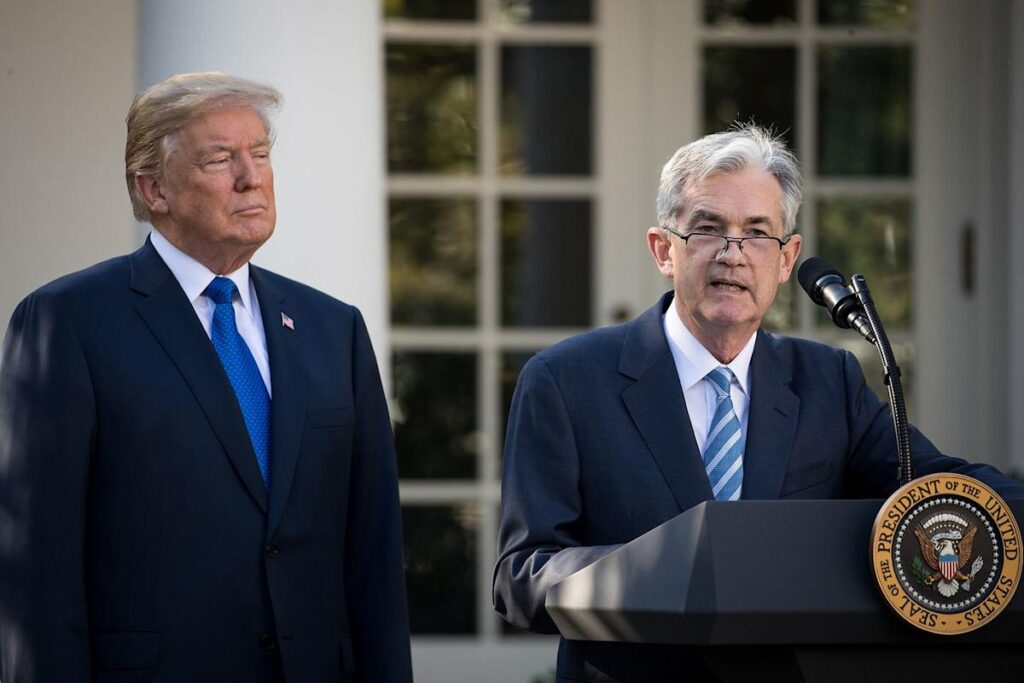U.S. stocks plunged sharply Monday after President Trump lobbed new insults at Fed Chair Jerome Powell, again pressuring him to cut interest rates.
In a post on Truth Social at 9:41 a.m., Trump claimed that “preemptive cuts” were being called for “by many” now that the economy was facing what he described as “virtually No Inflation.” He didn’t say who has called for the pre-emptive cuts, which the Fed rarely performs.
Without the cuts, Trump said, the economy now risks slowing, “unless Mr. Too Late, a major loser, lowers interest rates, NOW.”
“Powell has always been ‘To Late,’ except when it came to the Election period when he lowered in order to help Sleepy Joe Biden, later Kamala, get elected. How did that work out?”
Though Trump has long criticized Powell, whom he appointed during his first term, the president’s complaints have ramped up in recent days amid a major market reaction to his tariffs shock.
Economic adviser Kevin Hassett also said last week that the administration was “study(ing)” Trump’s options for removing Powell.
Firing Powell would be an unprecedented move: No president has ever removed a sitting Fed chair. The Fed has historically been a nonpolitical part of the government, and the prospect of Trump taking action has sparked concern that inflation would surge as he forced the central bank to ease up on its role of controlling price growth in favor of economic growth.
Markets extended their losses after the post, and by 1:30 p.m. ET saw some of the largest intra-day declines in weeks. The S&P 500 was down more than 3%, and has now declined 17% from its February peak. At 20%, it will enter a bear market.
The Dow Jones Industrial Average declined 1,100 points, or about 2.9%. The Nasdaq fell 3.4%.
Bond yields moved higher after briefly falling, meaning they were demanding a higher return for lending to the government.
In referring to the slowing economy, Trump may be becoming more attuned to the negative shock his tariffs strategy is creating to growth.
A growing chorus of Wall Street firms and analysts increasingly foresee the U.S. economy entering a recession, something real-time measures of gross domestic product (GDP) are also showing.
While it is true that the rate of inflation has slowed from a 9% high at the height of the pandemic, the measure of price growth most closely observed by the Fed remains above its 2% target and actually accelerated in February.
Not all White House officials appear to be on board with pressuring Powell. Just last week, Treasury Secretary Scott Bessent told Bloomberg TV that the administration would begin interviewing candidates for Powell’s successor this fall, adding it would give the Trump administration about six months lead time before Powell officially leaves office when his term is up next year. He gave no further details.
Though bond yields fell immediately after Trump’s post — meaning investors increased their purchases of U.S. treasury notes, something Trump is seeking — any effort to remove Powell would likely be met with a sell-off of bonds, said Mark Zandi, chief economist of Moody’s Analytics.
“Bond investors really don’t like Fed’s independence impaired, and if President actually did fire Powell, the bond market would throw up all over it and long term interest rates would go skyward,” he said. “It’s a really bad idea. A cornerstone of a well-functioning economy like our own is a well-functioning central bank. If we lose that, we lose our economy’s secret sauce.”
This article was originally published on NBCNews.com
Read the full article here


